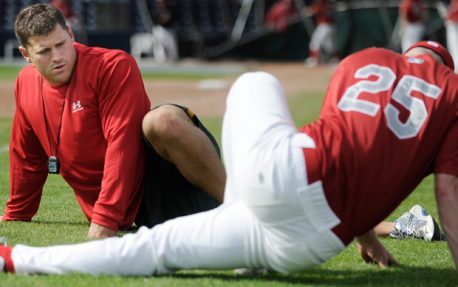BACKING BASEBALL 

With spring training right around the corner, baseball fever will soon be spreading. America’s pastime continues to grow in worldwide popularity. For those who have never been involved with the sport, some key questions may remain regarding the physical fitness demands placed on baseball players. In this blog, I will attempt to knock a few baseball training-specific myths out of the park!
Myth #1: Baseball players are not really athletes.
As someone who has been in a dugout next to athletes like Ricky Henderson, Billy Hamilton, Sonny Gray, Manny Ramirez, etc., I can tell you that there are many fine athletes on a baseball diamond with a special combination of raw speed, quickness and raw power. Bo Jackson, Deion Sanders, Brian Jordan are some great examples; as well as many high draft picks that gave up baseball and went on to excel in other sports. One of my mentors was a strength and conditioning coach at the University of Texas who could verify that Roger Clemen’s legendary squat workouts were a huge component to his exceptional velocity early in his career. As a former football player (and from my experience training them) I would estimate that a baseball position player needs to run below a 4.6 40 yard dash in order to be a legitimate base-stealing threat. Mike Trout is a great modern-day example of such an athlete. And even the players who may not seem especially athletic when compared to sports like football, basketball, etc. possess superior hand eye coordination to almost any other sport.
Myth #3: The human arm was not designed to throw a baseball at nearly 100 miles per hour.
The body was not necessarily designed to perform many of the impressive tasks that highly trained athletes demand of it – across a multitude of sports such as gymnastics, track & field throws, weightlifting, etc. However, with advances in human performance and education training – to include injury prevention exercises incorporated into a good training program and performed regularly – the arm can withstand excessive biomechanical forces time after time if proper muscle balance is achieved. (Ex : – relative strength of internal vs external rotators within the rotator cuff). To remain healthy, pitchers must spend hours each day properly warming up the arm, stretching and strengthening it along with its stabilizing and decelerating muscles on an almost daily basis.
Myth#5: Baseball players don’t like to train hard given the relaxed nature of their sport.
I have found the complete and total opposite to be true. Some of the best work ethics I have seen belonged to professional baseball players. Many have no problem putting in the extra work, even is season. In the offseason (typically November through February) baseball players enjoy pushing their body to the limits and watching the adaptations grow. As a general rule, many of them are highly self-motivated and extremely competitive, so they react well to a periodized plan with suggested loads, or timed agility and conditioning drills.
– CHRIS BORGARD
Stay tuned for future blogs, to include:
- Chris’ top tips for preventing athletic injuries
- Debate: Who are the best athletes in the world?
- When is the best time of day to work out?

Myth #2: It doesn’t take much skill to hit a ball.
Nothing could be further from the truth. Batters have less than two-tenths of a second (from the moment the baseball leaves a pitcher’s hand off an elevated mound just 60 feet away) to perform all of the following tasks at a minimum:
-recognize the spin of the baseball near the point where it was released
-determine whether the ball is hittable -i.e., a strike or a ball – and determine whether to start their swing of a weighted bat
-summon a perfectly timed equal inertia from the body in order to meet the ball and counter its momentum (average incoming speed nearly 90 mph) with clean bat contact right at the moment it crosses the plate.
Myth #4: Baseball players do not have to be in shape to play the game.
To counter the velocities mentioned above, baseball players must possess and maintain impressive strength and incredible power through the legs, hips, and stabilizing core muscles. The abdominal core must be strong and well balanced to resist injury while torquing at high speeds under extreme rotational strain. The forearms of baseball players (including pitchers) must be exceptionally strong to grip the bat and the baseball at high velocities. I have worked with several baseball players who could max out the measuring pin on the highest setting of a handgrip dynamometer.
In terms of cardio, baseball pitchers average HRs are routinely at or above the 170s (beats per minute) while pitching; in fact, starters often throw up to 100 pitches or more at max intensity. And position players? In addition to being agile enough to accelerate quickly around the bases and get a powerful start out of the batter’s box or a jump into stealing a base, one must remember that over the course of a long summer season they play 160 games in a six month span – often getting no more than 3 off days each month. To be able to go out and perform each night even when the body may not be feeling the best is a total war of attrition, and it takes much time and effort to building and maintaining a strong body resistant to injuries over such a long time span.

